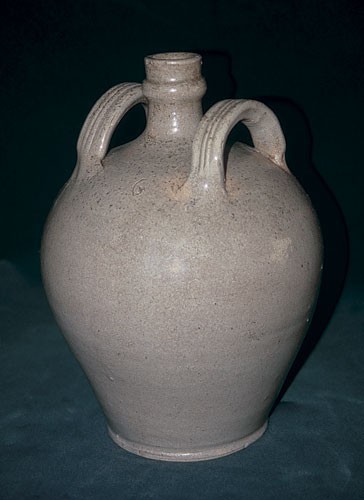
Two-handled vessel, probably American, possibly nineteenth century. Alkaline-glazed stoneware. H. 9 1/2". (Author’s collection; unless otherwise noted, all photos by author.) This small mystery vessel, which can be traced only so far as the Chicago antiques trade, shows indications of an early Southern stoneware jug (bulbous form, feldspathic alkaline glaze, foot ledge, collared neck), but the peculiar horizontal loop handles, reeded along their flat tops, depart from the vertical handle that defines a jug.
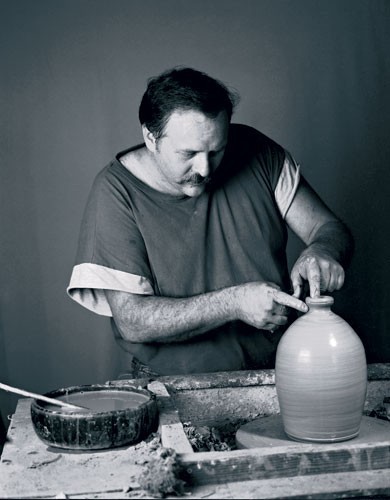
Dwayne Crocker of Gillsville, Georgia, shapes the neck of a jug on his electric wheel, 2001. (Photo, Chris Swanson.) The vertical loop handle that also defines the form will be added once the clay dries a bit.
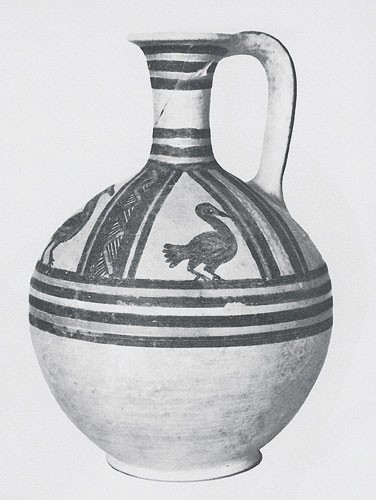
Bichrome wheel-made jug, Gaza, Plestine, ca. 1500 B.C. Earthenware. H. 11 3/8". (Courtesy, Israel Antiquities Authority, Jerusalem.)
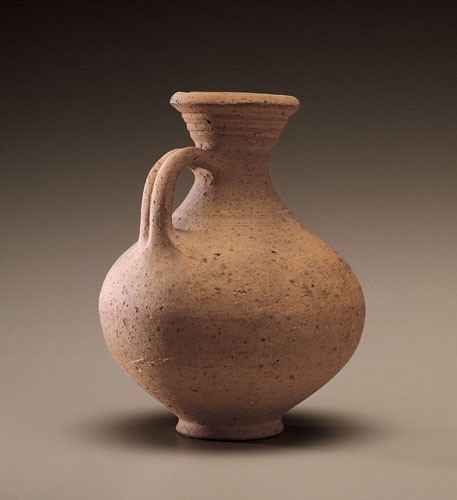
Romano-British jug, first half of second century a.d. Unglazed earthenware. H. 5 1/8". Noël Hume Collection; photo, Gavin Ashworth.) This locally made jug was recovered by a fisherman off the tidal Upchurch Marshes, Kent, England.
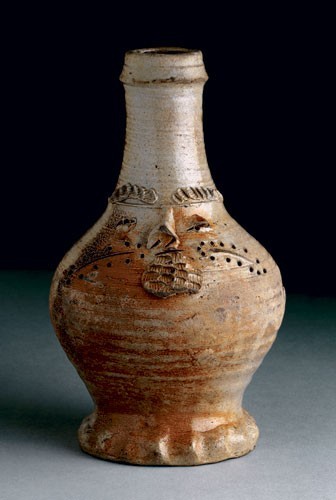
Jug, Raeren or Aachen, Germany, ca. 1475–1525. Stoneware. H. 8 3/8". (© The Trustees of The British Museum.) This salt-glazed jug has an applied face, strap handle, and thumbed base.
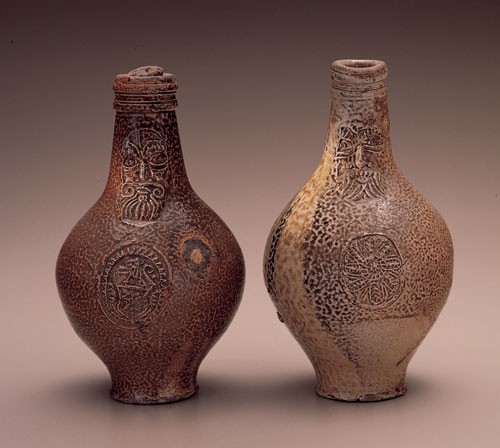
Graybeards, Frechen, Germany, ca. 1660–1665. Salt-glazed stoneware. (Noël Hume Collection; photo, Gavin Ashworth.) The vessel illustrated on the left was recovered from the Thames at London. The one on the right was found beneath the hearth of a cottage at Stratford St. Mary, Suffolk. Both were used as “witch bottles.”
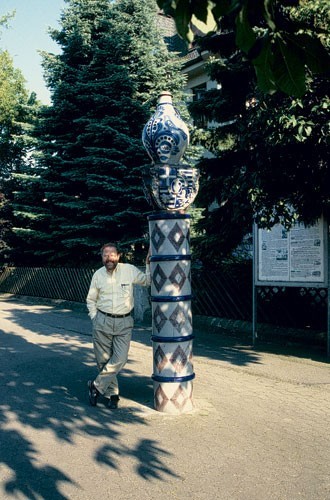
The author, with a modern monument in Höhr-Grenshausen, Germany, featuring a cobalt-decorated jug atop the town arms. (Photo, Linda Carnes-McNaughton.) Such emblems of occupational identity are found throughout the Westerwald’s Kannenbäckerland (mug-baking district), where the salt-glazed stoneware tradition is still active.
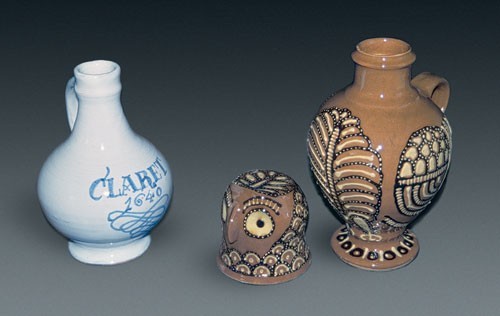
Reproduction jugs, John Hudson, Mirfield, West Yorkshire, late twentieth century. Left: Claret jug, after a London delftware example. H. 6 3/4". Right: Slip-trailed owl jug after one attributed to Thomas Toft of Staffordshire, with its top beside it. H. 8 3/4". (Author’s collection.)
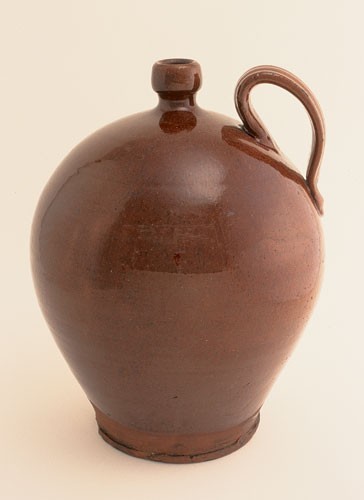
Jug, County Down, Northern Ireland, early to mid-1800s. Lead-glazed earthenware. H. approx. 12". (Courtesy, Museum of Country Life, Castlebar; photo, National Museum of Ireland.) Little has been published on Irish country pottery; this example of the jug form is the only one known to the author.
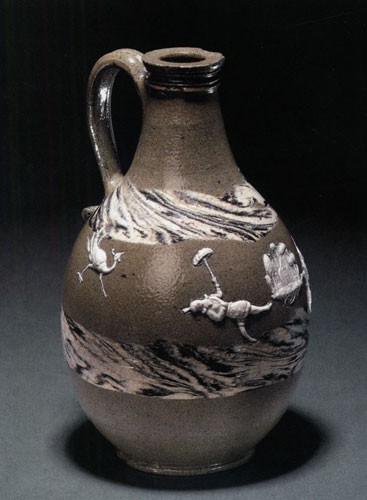
Rhenish-style jug, workshop of John Dwight, Fulham, England, last quarter of seventeenth century. Gray salt-glazed stoneware, with varicolored clay and sprig-molded figures. H. 7 1/2". (Willett Collection; © The Trustees of The British Museum.)
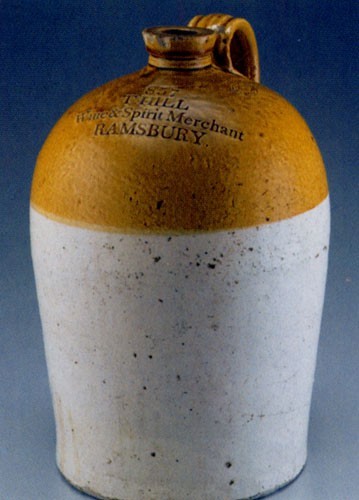
Two-tone jug, Bristol (Avon County), England, late 1800s. Stoneware, with Bristol glaze over partial iron wash. H. 15 1/2". Marks: POWELL + BRISTOL; “857 / T HILL Wine & Spirit Merchant / RAMSBURY.” (Photo, Gavin Ashworth.) Developed in 1835, Bristol glaze contains feldspar, whiting (as a flux), and often zinc oxide (as a whitener and opacifier). The jug was made for a merchant at Ramsbury, a village in the adjacent county of Wiltshire. The Powell of the mark probably refers to the firm of William Jr. and Septimus, descendants of William Powell, who codeveloped Bristol glaze. The firm was sold to Charles Price in 1906.

Price list of Manhattan stoneware potter Clarkson Crolius, 1809. (Courtesy, American Antiquarian Society.) Early illustrations of jugs associated with the word help establish when the American meaning came about.

Hardin E. Taliaferro (“Skitt”), Fisher’s River (North Carolina) Scenes and Characters (New York: Harper and Brothers, 1859), pp. 266–67. This image shows the American notion of a jug.
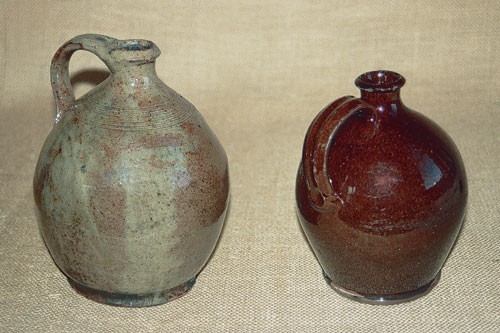
Jugs. Lead-glazed earthenware. Left: New England (Massachusetts provenance), ca. 1800. H. 7 3/4". The lead glaze is accented with copper over shoulder tooling. Right: Pennsylvania, early to mid-1800s. H. 6 1/2". Iron or manganese-colored lead glaze and extruded handle. (Author’s collection.) Both vessels have a foot-ledge and pronounced lip but are distinguished by characteristic regional handle placements.
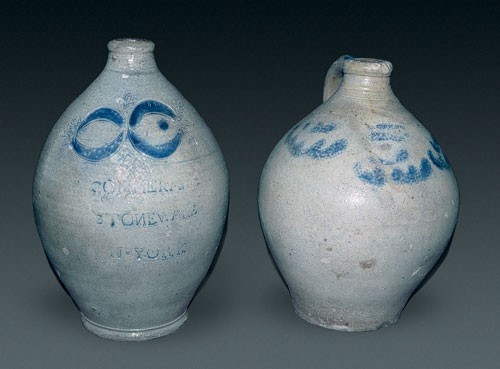
Jugs. Manhattan. Salt-glazed stoneware. Left: Thomas Commereau, ca. 1815. H. 11 3/4". Right: Clarkson Crolius Jr., ca. 1840. H. 11". (Author’s collection.) Both vessels are in the Germanic tradition, with maker’s marks, handle terminals, and floral designs highlighted with cobalt blue.
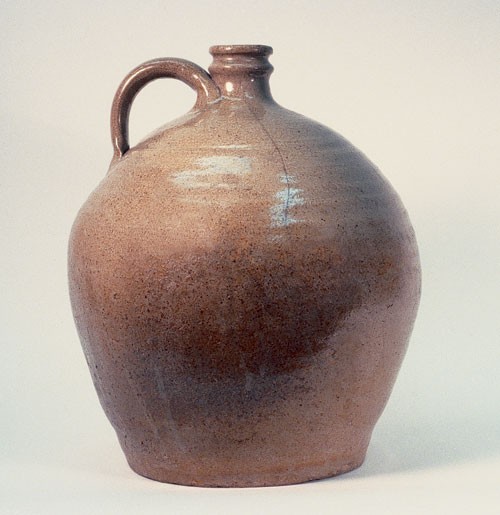
Jug, attributed to Abner Landrum’s Pottersville stoneware manufactory, 1821. Alkaline-glazed stoneware. H. 14 1/8". Date incised under feldspathic alkaline glaze. (Ex-collection of Tony and Marie Shank; photo, courtesy McKissick Museum, University of South Carolina.) This vessel is the earliest dated Edgefield District, South Carolina, jug. Its double-collared neck became the norm for antebellum Edgefield jugs.
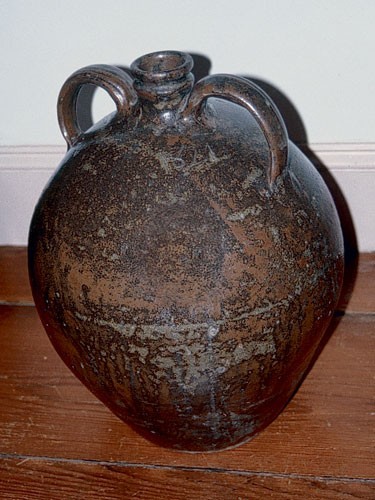
Two-handled jug, attributed to Abraham Massey, Washington County, Georgia, 1821. Alkaline-glazed stoneware. H. 18". Date incised under alkaline glaze. (Courtesy, Collection of Levon and Elmaise Register.) This is the earliest known dated Georgia pot. Associated with Abner and John Landrum back in South Carolina, Massey and Cyrus Cogburn introduced alkaline glazes and the Edgefield-style double-collared neck to middle Georgia.
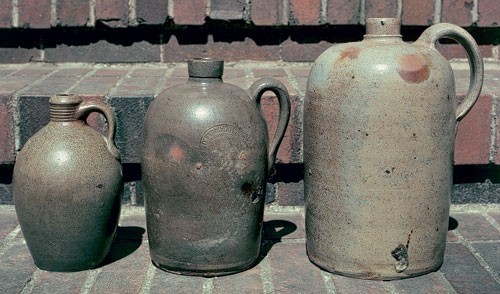
Jugs. Salt-glazed stoneware. Left: Nicholas Fox, Chatham County, North Carolina, ca. 1840. Center: retailed by Luther Funkhouser, Strasburg, Virginia, 1890s. Right: Peter Herrmann, Baltimore, Maryland, 1890s. (Ex-collection of Charles G. Zug III; photo, Charles G. Zug III.) These vessels illustrate the general shift in America from curved to straight sides.

Stoneware jug, F. M. Warrick, Sand Mountain, Alabama, 1878. H. 16". (Courtesy, Collection of Ron Countryman.) This jug bears a rare stamped date and combed decoration under the ash glaze. The moderately curved shape and incised lip are typical for the period.

Stoneware jug, Randolph County, Alabama, ca. 1900. Salt-glaze over Albany slip. H. 13 1/2". (Author’s collection.) By this time the typical American jug had become straight-sided and lost its lip.
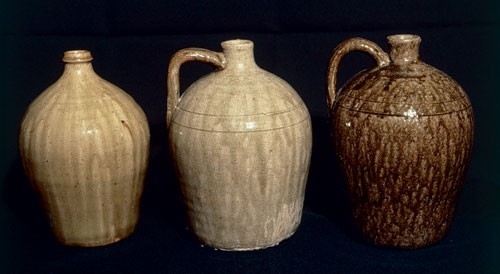
Jugs, White County, Georgia. Alkaline-glazed stoneware. Left: David Dorsey, ca. 1850. “Flint” subtype of lime glaze. H. 9 1/4". (Private collection.) Center: Cheever Meaders, 1950s. Flint glaze. H. 9 3/4". (Author’s collection.) Right: Lanier Meaders (who maintained his father’s accenting lines at shoulder), 1972. Ash glaze. H. 9 3/4". (Author’s collection.) These jugs illustrate continuity in shape at some Southern workshops. Except for their lack of a lip, ovoid Meaders jugs could be mistaken for antebellum ones.
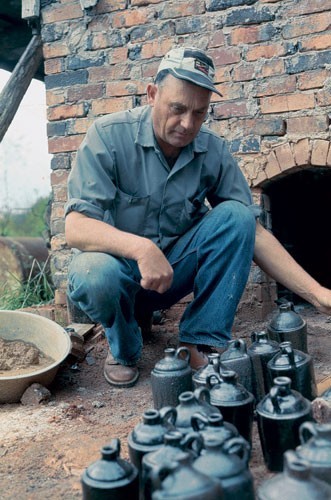
Lanier Meaders, Mossy Creek, White County, Georgia, 1974. Meaders unloads small, ash-glazed “shoulder” jugs from his wood-fueled, rectangular “tunnel” kiln. He and his father, Cheever, both made this cylindrical style of jug alongside the earlier ovoid shape.

Eddie Averett’s Crawford County, Georgia, “groundhog” kiln, 1890s. (Photo, courtesy Georgia Geologic Survey.) The photograph shows whiskey jugs ready for sale to local moonshiners or licensed distilleries in nearby Macon, ranging in shape from squatty “beehive” to ovoid to cylindrical.

Moonshine still, Savannah, Georgia, ca. 1890. (Photo, William O. Wilson, Vanishing Georgia Photographic Collection, Georgia Division of Archives and History, geo139-86.) The “shoulder” jug at center, with two-tone Bristol and Albany-slip glazes, is machine-molded; the salt-glazed jugs on either side are hand-thrown.
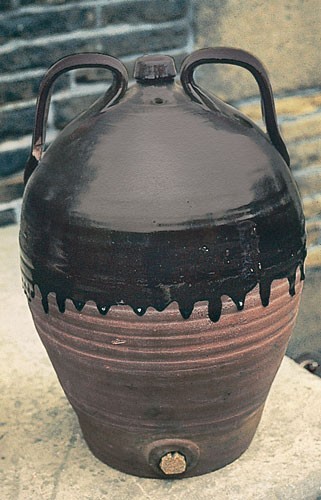
Cider jug, Halifax, West Yorkshire, England, late 1800s. Lead-glazed earthenware. H. approx. 14 1/4". (Courtesy, Shibden Hall and Folk Museum, Calderdale Metropolitan Borough Council—Museums and Arts, England.) Leaving the lower wall unglazed is said to have caused the cider to “roll,” accelerating fermentation; the hole beneath the neck held a loose stick that allowed gas to escape.
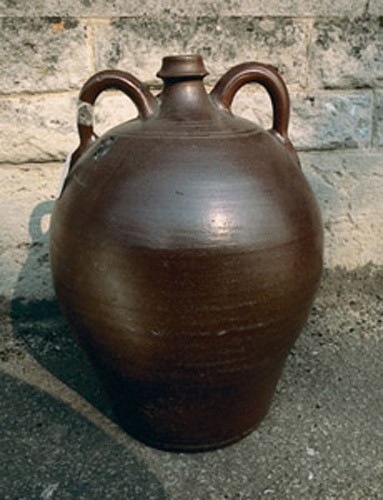
Four-gallon jug, Liverpool area, Merseyside, ca. 1830. Brown salt-glazed stoneware. H. 16 1/2". When found on the East Coast such vessels frequently are misidentified as American. This example was photographed at an antiques shop in England.
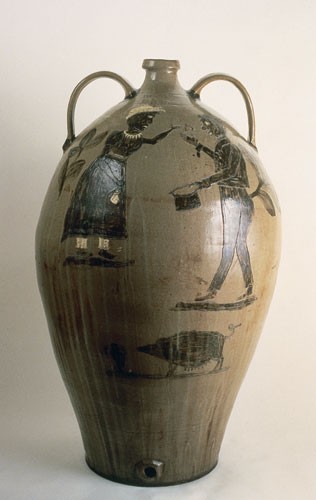
Water cooler, attributed to Thomas Chandler, Phoenix Factory, Edgefield District, South Carolina, ca. 1840. Stoneware. H. 31 1/4". (Courtesy, High Museum of Art, Purchase in honor of Audrey Shilt, President of the Members Guild, 1996–97, with funds from the Decorative Arts Endowment and Decorative Arts Acquisition Trust; photo, McKissick Museum, University of South Carolina.) The toasting slave couple was brushed under the alkaline glaze in iron-stained and kaolin slips within incised outlines, whereas the sow below (facing a similar pot), the handle terminals, and the leafy vine encircling the other side were painted freehand.
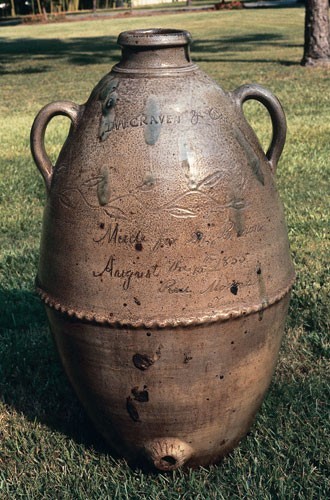
Water cooler, Tinsley Craven, Henderson County, Tennessee, 1855. Salt-glazed stoneware, with incised vine design and fluted joint reinforcement. H. 26 1/8". (Ex-collection of Tony and Marie Shank.) With its wide mouth, this piece approaches fountain-type coolers but could still be considered a jug.
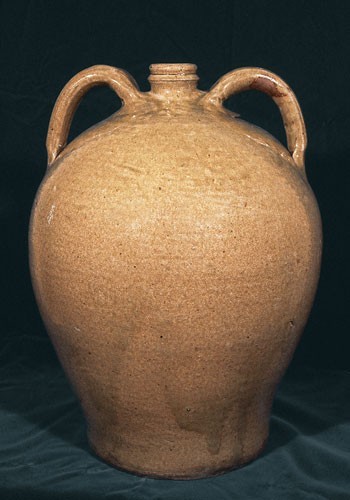
Syrup jug, attributed to Nathaniel Ramey pottery, Edgefield District, South Carolina, late 1830s. Alkaline-glazed stoneware. H. 16". (Author’s collection.) The bulbous shape of this four-gallon example is typical of these vessels.
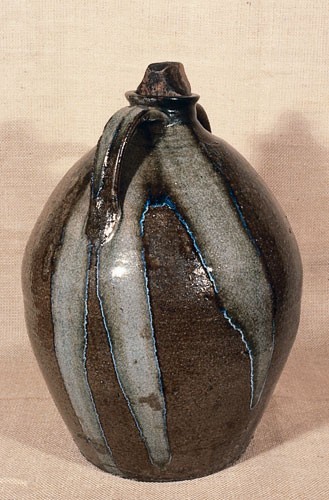
Syrup jug, Catawba Valley, North Carolina, late 1800s. Alkaline-glazed stoneware. H. 16 3/8". (Author’s collection.) The decorative technique of placing broken bottle glass on handles and rim before firing to melt in contrasting streaks is found mainly on North Carolina stoneware. The neck was widened to facilitate pouring the cane syrup, requiring a carved wooden plug to fit it.
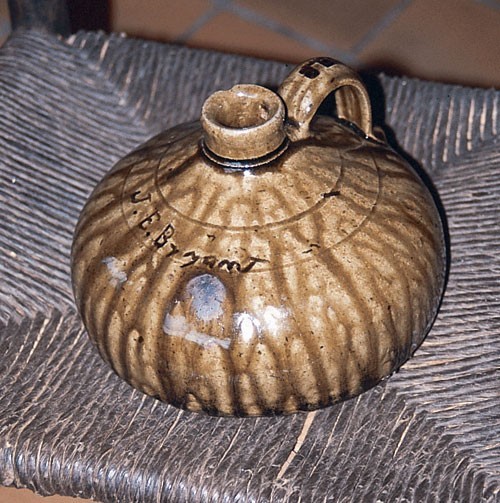
Buggy jug, attributed to Billy Bryant, Crawford County, Georgia, late 1800s. Alkaline-glazed stoneware. H. 5 1/4". Mark: stamped “BB” on top of handle; presentation inscription “J. E. Bryant.” (Courtesy, Museum of Southern Stoneware at River Market Antique Mall, Columbus, Ga.)
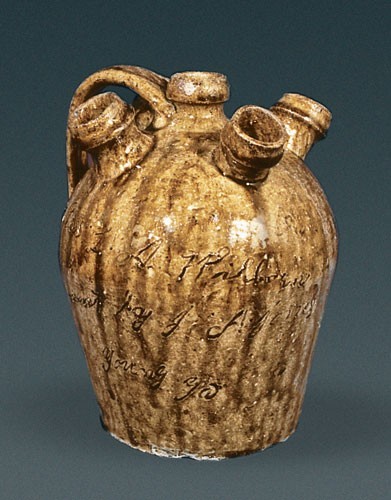
“Flower jug,” James Jones, Union County, Georgia, 1870s. Ash-glazed stoneware. H. 9". Marks: signed by the maker; inscribed “Miss L. A. Wilborn.” (Author’s collection.) A previous owner’s oral history claims that the five spouts of this mountain “wedding jug” were meant for the minister, bride, groom, best man, and maid of honor to drink from at the ceremony.
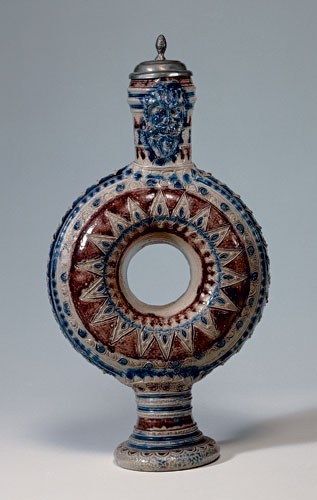
Ring jug with lion mask, Westerwald, Germany, third quarter of seventeenth century. Salt-glazed stoneware with cobalt and manganese. H. 17 5/8". (Courtesy, Hetjens-Museum Düsseldorf/Deutsches Keramikmuseum, Düsseldorf, Germany.)
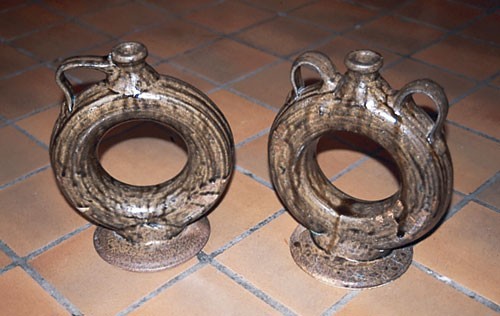
Ring jugs, attributed to Crawford County, Georgia, late 1800s. Alkaline-glazed stoneware. (Courtesy, Museum of Southern Stoneware at River Market Antique Mall, Columbus, Ga.) Although this pair of jugs was made by the same potter, the handles on each appear to be the work of different hands.
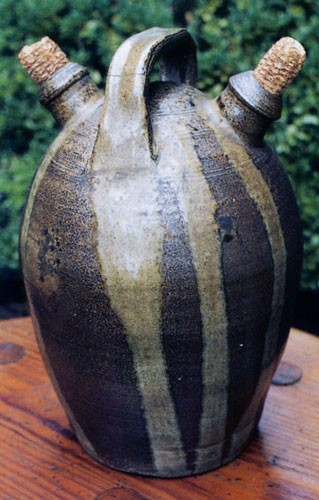
Monkey jug, central North Carolina, ca. 1860. Salt-glazed stoneware, with melted-glass decoration and corncob stoppers. H. 12". (Courtesy, Mary Frances Berrier Collection.) According to oral history, a slave drank from one spout and his master from the other.
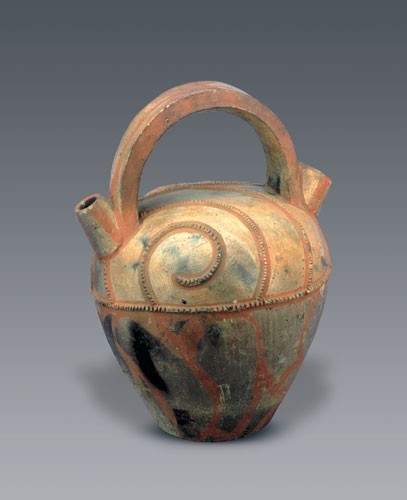
Monkey jug, Ekoi people, Nigeria, West Africa, probably early 1900s. Unglazed earthenware. H. 13 3/8". (© The Trustees of The British Museum.)
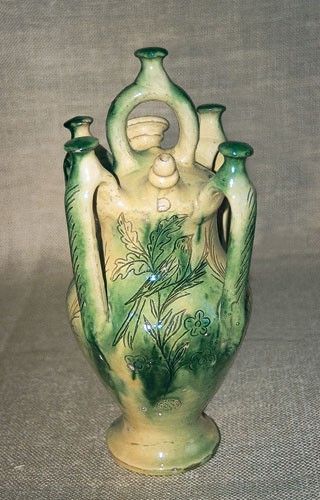
Botijo, Felix Perez workshop, Cuenca, Spain, mid-nineteenth century. Lead-glazed earthenware. H. 14". (Author’s collection.) Made as a tourist souvenir, the monkey-jug form of this vessel is elaborated with vertical loop handles, button finials, and a sgraYto bird and foliage with copper-green highlighting.
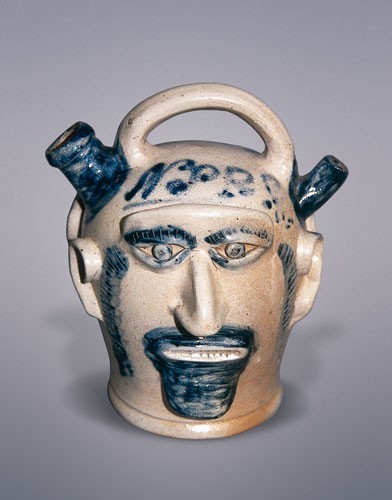
Two-face monkey-form jug, attributed to Henry Remmey Jr. or his son Richard, Philadelphia, Pennsylvania, 1858. Salt-glazed stoneware. H. 11". (Ex-collection of Tony and Marie Shank; photo, Tony Shank.) Highlighted with cobalt blue, this dated jug might represent an Americanization of the German graybeard tradition.
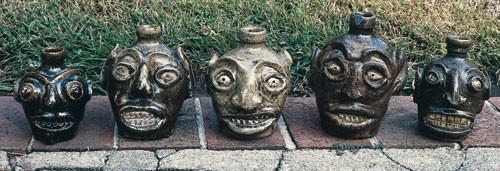
Face jugs, attributed to slave potters at Thomas Davies’s Palmetto Fire Brick Works, Bath, South Carolina, early 1860s. Alkaline-glazed stoneware, with inset kaoline eyes and teeth. (Ex-collection of Tony and Marie Shank.)
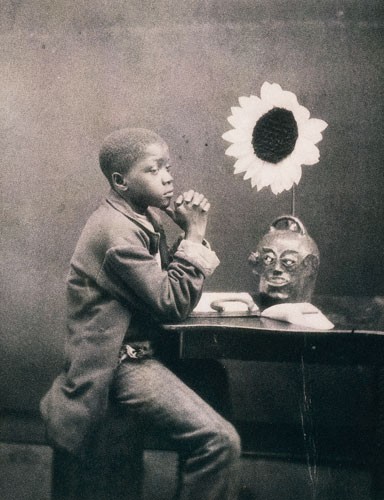
“An Aesthetic Darkey,” from a series of stereoscopic cards by photographer J. A. Palmer of Aiken, South Carolina, 1882. (Courtesy, J. Garrison Stradling.) This earliest known published image of an American face jug has a monkey form and probably was made by a local (Edgefield District) African-American potter.
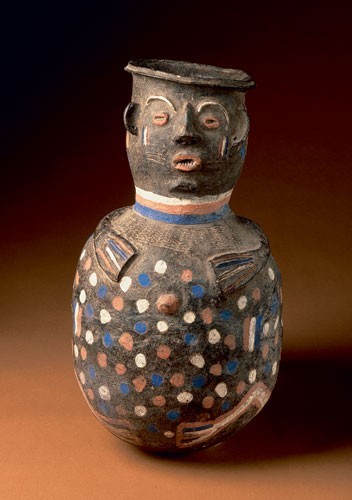
Figurative jar, Mambila culture, Cameroon, twentieth century. Earthenware with polychrome decoration. H. 20". (Photo, courtesy Douglas Dawson.)
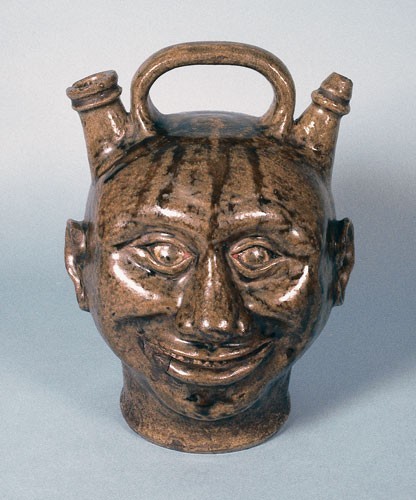
Monkey-form face jug, Edgefield District, South Carolina, ca. 1850. Ash-glazed stoneware. H. 11". Mark: stamped “CHANDLER / MAKER.” (Private collection; photo, McKissick Museum, University of South Carolina.) The happy countenance on this jug contrasts with the angry ones of a decade later by slave potters in the same area.
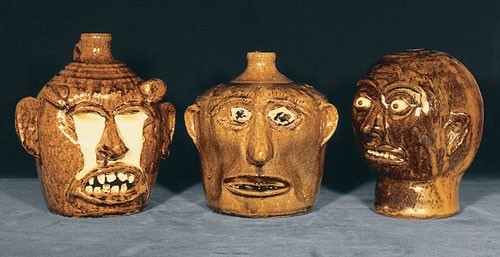
Face jugs and wheel-thrown “wig stand,” Lanier Meaders, White County, Georgia, 1968–1974. Alkaline-glazed stoneware. H. (left to right) 9 3/4", 8 3/4", 9". (Author’s collection). With these items Meaders displayed his sculptural skill, creativity, and sense of humor.
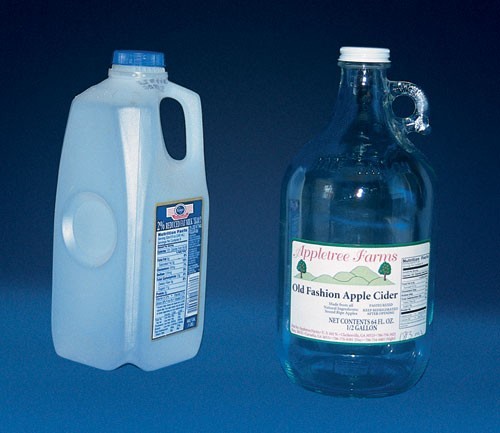
Examples of modern functional jugs, made of glass and plastic rather than clay.
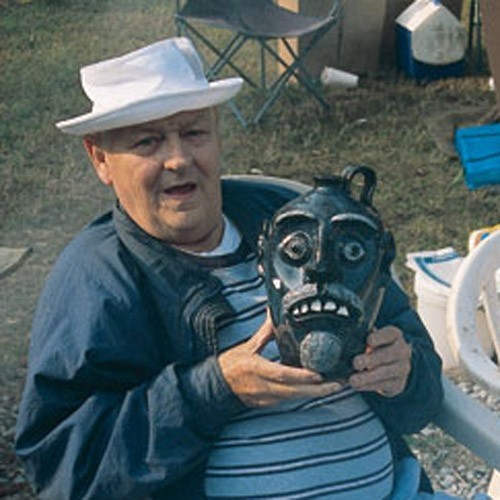
Fifth-generation potter Bobby Ferguson of Gillsville, Georgia, with one of his face jugs in 2004, a year before his death. An ancestor of his may have introduced face jugs to north Georgia from antebellum Edgefield District, South Carolina.
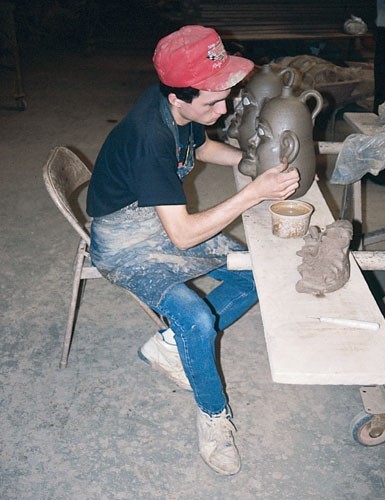
Sixth-generation potter Matthew Hewell of Gillsville, Georgia, sculpts face jugs, 1992. Lanier Meaders’s success influenced Matthew’s father, Chester, to revive the Hewell face-jug tradition.
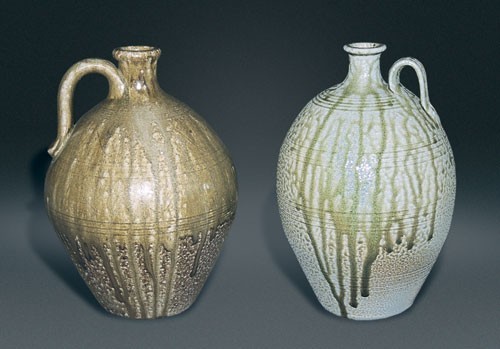
Jugs, late twentieth century. Salt-glazed stoneware. H. 11 1/2". Left: David Stuempfle. Right: Ben Owen III, Seagrove, North Carolina. (Author's collection.) Both vessels have pronounced lips, tooled decoration, and drips caused by dumping the salt directly over the pots through holes in the kiln arch, although each has a very different handle, and the jug on the left has an ash underglaze. Seagrove is a community of about one hundred shops, a dozen of which are rooted in local tradition.
